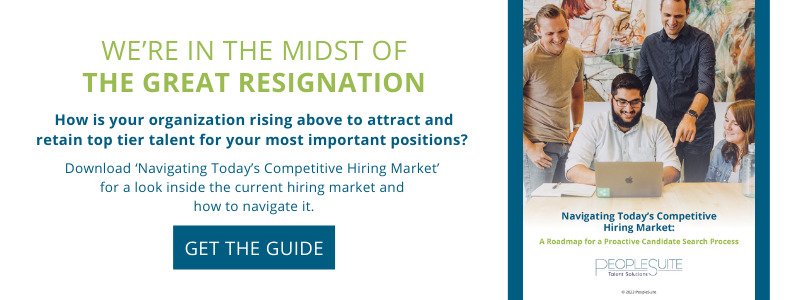There is a lot of pressure to find the right people for your company right now. It’s costly and time-consuming to hire new employees, so you need to find the perfect candidates as quickly as possible. Even when you are running short on time to get a position filled, you have to make sure you hire a skilled worker that fits your company values and adds to your company culture.
The process isn’t as hard as you might think.
Finding the Ideal Candidate
First of all, ‘ideal’ is soft and fuzzy language. It’s the vague kind of term that will mean one thing to you and a very different thing to the coworker sharing a breakroom with the new hire. When we say ideal, we really mean a candidate that has all the requisite skills to do the job and is a good culture fit within the organization.
When it comes to their ‘briefcase,’ you can’t really define ideal. This includes whatever experiences, education, personality traits, behavioral/metal build and perspectives that they bring with them. You might be making assumptions without giving true potential a chance if you hold to stringent standards here.
So, to determine the best option, you will first have to define the job and then prioritize the considered necessary characteristics and skillsets. Here are 7 steps to defining the ideal candidate.
Define Accountabilities
Drafting a detailed job description might seem like a really obvious step in the hiring process, but many don’t take the job description far enough. Take time to get into the grain and really develop an understanding of what you need on the deepest level.
- Sit down with all stakeholders around a job
- Who touches that job?
- Who does this person serve?
- What do the people in the field need?
- Define the skills and personality type needed
- Does this position require a go-getter?
- Do you need a listener or a person really quick on their feet?
- Are there proficiencies they need from the start, or can you teach certain skills with on-the-job training?
- Write an Accountability Matrix rather than a position description
- Create a list of different responsibilities that make up that job.
- Determine how much time or focus is required for each responsibility point of the position
- Rank each responsibility point of highest importance to least importance
- Consider which stakeholders are most impacted by the various points on the list
This will help you determine who should be helping interview which candidates and how much importance should be placed on the various requirements.
Realize Perfection Doesn’t Exist
It’s easy to create a unicorn in your job description. You can get so caught into the process that you forget there are very real people with shortcomings that will still do incredible work. However, to best understand your vision and these shortcomings, you do need to understand what perfect looks like.
If you could build a robot for your job, what would it do?
Assess your existing company rock stars. What are they doing right?
Perfect does not exist, but you can get as close to the unicorn candidate as you possibly can with weighted pieces you gather from the interview process. This is where the Accountability Matrix can help.
Fill the Role
Great employees don’t fit every hat. You might have a top talent candidate that just doesn’t fit the role quite right. It isn’t fair to them (or you) to try to shove the glass slipper onto their foot.
For example:
Say there’s a company with 500 stores across the country. This company likes to promote from within to support their employees and build loyalty. District managers cover 15 stores each. The ‘peter principle’ is in effect, which means these employees are going to be raised past their capabilities at some point. More often than not, newly promoted managers fail in a new position as district manager because the promotion process was based on their abilities within their initial management position. They were promoting the best store managers to district managers, but when they failed, they’d lose another top employee from the organization.
Rather than filling the position with a “great employee,” you need to find a great employee with the right fit. This is why it’s so important to define the role and identify the unicorn (or robot) that would perfectly fill that role.
- Assess your existing employees
- Define behavioral targets
- Identify which candidates are behaviorally suitable for the new role
- Examine new talent as well—don’t limit yourself to only existing hires
This could completely shift your mindset from what you think is important and what is actually important to the job.
Weight Your Interviews
There are a number of components to your interview process. Each step shouldn’t solely rule a candidate out, but it will give you insight into the talent.
- Resume
- Cover letter
- Interview
- Writing sample
- Behavioral assessments
If you don’t know what you’re looking for, the use of an assessment tool is not helpful. They aren’t meant to be screening tools. An assessment tool can be used as a deciding factor if there are multiple ‘ideal’ candidates and it can help you pinpoint weaknesses that you may want to address in the onboarding process. Something like a PXT Report can tell you about the candidate’s thinking style, interests and behavior traits, but it doesn’t give true insight into how they will fit into your company and the open job position.
Hire Proactively
When you need to fill a role, there is a tendency to hire reactively. You have a position that was just vacated, so you want to fill the gap. The problem is, more than likely that ex-employee didn’t start where they ended.
Here’s an example:
Mary was a 7-year veteran employee who quits suddenly. She was a key player and you now feel the gap. Her job description as a “bookkeeper” probably hasn’t changed in 7-years, but it’s evolved over time. She has various important responsibilities that need to be refilled that now include aspects of handling benefits, payroll, employee relations, etc.
The reactive (panic) model says: “I need another Mary!”
The proactive (reflective) model says: “I need another employee that can eventually grow into Mary’s role. I may need to redistribute tasks.”
You are going to have to look at the job “Mary” was filling before she left—not what she was hired to do. You will have to recognize the things she learned along the way and not pressure your candidate to already have that knowledge. You may have to redistribute your jobs until the new hire is ready to take on more.
Remove the Mask
One of the trickiest parts of hiring is getting a true picture of a candidate. It’s easy to be on your best behavior for an hour or two during an interview. In order to find the ideal candidate for a job position, you need to get them to put the mask down.
One way to do this is to ask unexpected and open-ended questions during the interview.
But, another key way to help them let down their guard is to invite them to something your team normally does. Do you have a donut Friday or go out for tacos on Tuesday? Bringing along a candidate for an outing can help you get to know them in a much more realistic setting. It can also help them appreciate the fun part of your company culture.
You can see how they click (or don’t click) with other people they would normally spend time with on the job.
Question References
Ask unexpected questions—not just during the interview, but to references as well.
References are a key part of verifying any potential candidate. You should take full advantage to use those references to their fullest potential in order to get more information about your candidate.
You will need to follow the HR laws of your state, since they vary. But there are a variety of ways to get insight into the personality of a candidate from their references. You don’t need to ask for any questionable details about the end of their working relationship. Never ask questions that could seem discriminatory.
Instead of only verifying work dates, you can ask about some non-controversial aspects of their working habits. Ask about their creativity level or sensitivity to other employees. Ask about their sense of humor or professional appearance from day-to-day.
While you can ask about work ethic, reliability, training, and skill sets in most cases, the reference might be hesitant or vague. Past employers tend to be careful about how much information they give out because they don’t want to risk a lawsuit.
You can take this opportunity to ask about the things that are important to your company culture. The unexpected questions about small daily details are far less alarming and more likely to be answered by a past employer.
The Hiring Process Shouldn’t be Guesswork
There is a lot of pressure and importance that comes with hiring new candidates. This process shouldn’t be guesswork. You can streamline your process for more efficiency to reduce the cost of hiring new talent. The better you get at the hiring process, the lower your turnover rate and the more cost-effective you will be for your company’s bottom line.
There are a lot of people feeling this pressure in today’s climate. With so many changes in the workplace, the hiring process is harder than ever.
If you need help optimizing your hiring process, we can help.
At PeopleSuite, we don’t post a job and hope for the best. We proactively find the perfect candidates and run them through screening processes designed to find you the right fit. Talk to us today and let’s get started.










